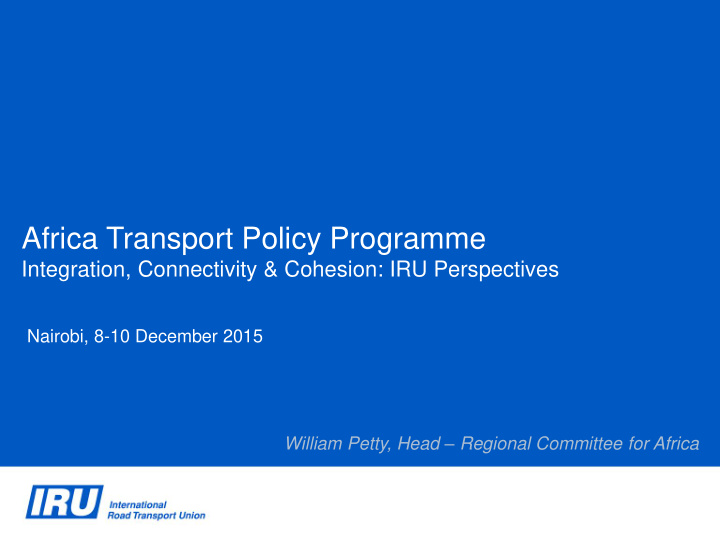



Africa Transport Policy Programme Integration, Connectivity & Cohesion: IRU Perspectives Nairobi, 8-10 December 2015 William Petty, Head – Regional Committee for Africa
IRU B ACKGROUND & M ISSION
IRU Background Founded in 1948 in Geneva National road transport associations from 8 western European countries IRU in 2015: Members in 74 countries on the 5 continents , from large fleets to individual owner-operators Our mission today is: “ ... to ensure economic growth and prosperity via the sustainable mobility of people and goods by road worldwide” 3
Pre-requisites for efficient goods transport Public Sector Private Sector Market • Efficient border & transit • Compliance with trade and • Level playing field procedures transport regulations • Fair competition • Efficient enforcement of • Efficient transport transport regulations management and driving • Good intermodal interconnectivity • Adequate road infrastructure • Efficient vehicles 4
E FFICIENCY : THE PUBLIC SECTOR ’ S “ SOFT ” ENABLING ENVIRONMENT
Harmonisation of goods transport controls No need to reinvent the wheel – consider implementing existing instruments: • International Convention on the Harmonization of Frontier Controls of Goods • Harmonisation of border procedures for goods (Customs PLUS medico-sanitary, phyto-sanitary, veterinary, standards) • Harmonisation of controls for transport (drivers’ visas, vehicle inspection, • International Technical Inspection Certificate • International Vehicle Weight Certificate 6
TIR – facilitating cross-border & transit PPP approach to trade facilitation – costs & risks of implementation & operation borne by private sector 69 contracting parties 58 operational TIR countries Up to 3 million carnets issued per year Over 35,000 operators worldwide authorised to operate under TIR 1 billion USD in Customs guarantees... every day ... 7
Key Benefits of UN TIR Convention For Customs For Traders Risk sits with guarantee chain One document, one guarantee Authorised operators only Simple & cost effective Secure load compartments No bond deposited Highly secure, fraud-proof carnet No need to apply customs valuation and negotiate bond value 0.001% claims rate Global – not bi-lateral or regional. Mutual recognition PPP structure – national entities issue carnets in Traders can submit advance data electronically to partnership with national Customs administration Customs Customs can use their own systems to process Help with unclogging ports TIR movements 8
TIR: helping to implement TFA • Article 11: Freedom of Transit • Article 10: Formalities connected with Importation, Exportation and Transit • Article 9: Movement of Goods intended for Import under Customs Control • Article 7: Release and Clearance of Goods 9
TIR engagement in sub-Saharan Africa Kenya feasibility study EAC regional transit bond study Northern, Maputo, Walvis Bay Corridors ECOWAS TIR workshop Zambia, Swaziland, South Africa 10
eTIR TIR Holder: Order a eGuarantee online Association: Approve and issue the eGuarantee TIR Holder: Pre-declare the transport and GO! 11
P RIVATE SECTOR ’ S ROLE IN DRIVING EFFICIENCY
Generic transport operation cost structure PROFIT PROFIT 24% Fuel 24% Fuel Variable costs Variable costs 6% Maintenance and repair 6% Maintenance and repair 3% Tyres 3% Tyres Income Income Labour costs Labour costs Total costs Total costs 33% Salary, social costs and taxes 33% Salary, social costs and taxes 3% Insurance 3% Insurance 3% Vehicle taxes 3% Vehicle taxes Fixed costs Fixed costs 19% Capital costs 19% Capital costs 8% Administration 8% Administration Source: Volvo 13
Driver Qualification – a key component to ensure commercial operations safety and efficiency CPC Driver Programme Objectives: • Professionalisation; • Road Safety; • Efficiency; • CO2 Reduction; • Improvement of the image of the Industry; In full compliance with the UN consolidated resolution on road traffic (Annex IV, V3.4 and VI) and EU directive 59/2003/EC 14
CPC Manager Programme Structure: • The CPC programme covers the initial qualification for professional transport managers as defined by the IRU Academy. The following list of subjects are covered: • Civil Law • Commercial Law • Social Law • Fiscal Law • Business and financial management of undertaking • Access to the market • Technical standards and technical aspects of operation • Road Safety • Health • It is left to individual training organisations to deliver the programme and modify its sequence according to local needs, methodologies and pedagogical approaches. Additionally, relevant national legal provisions have to be integrated in the programme. 15
The IRU Academy at a glance 16
Road Safety – a global issue 17
Professional driver training is key … 85% of accidents caused by human error 18
TRANSPark – tool for drivers Map view Itinerary Parking area Community Notifications detail 19
TRANSPark in Africa 20
TRANSPark – GPS tracking 21
TRANSPark – GPS tracking Sustainable corridor monitoring for RECs, and corridor organisations GPS tracking for fleet managers GPS tracking for transit movements 22
T HE M ARKET
Fair competition Level playing field – national and regional Access to market and freight based on qualitative criteria IRU/WB Toolkit collaboration 24
Recommend
More recommend